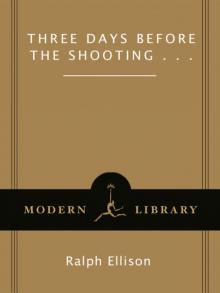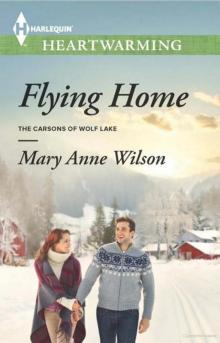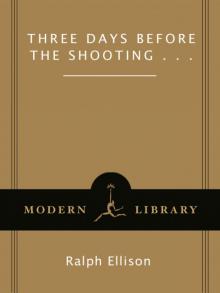- Home
- Ralph Ellison
Flying Home and Other Stories
Flying Home and Other Stories Read online
Acclaim for Ralph Ellison’s
FLYING HOME
and Other Stories
“Eye-opening … remarkable.… Ellison puts to shame most of this season’s new story collections.… Anyone who thinks writers are made, not born, should read Flying Home.”
—New York Observer
“We witness Ellison’s increasingly assured control of language, his experiments with black folklore and his refining of his great themes.… Reading Flying Home … is much like listening to some young muscian riffing on the changes of older, more experienced artists until, eventually and inevitably, he slips the breaks and finds his own voice, soaring on wings of song.”
—Washington Post
“Ripe with the forceful musicality, unmistakable politics, and fine promise of one of our best-ever black writers.”
—Elle
“Marvelous.… Glorious, pre-Invisible Man riffs—and another fine addition to the Ellison oeuvre.”
—Kirkus Reviews
About the Author
Ralph Ellison was born in Oklahoma City in 1914. He is the author of Invisible Man (1952), which won the National Book Award and became one of the most important and influential postwar American novels. He published two volumes of nonfiction, Shadow and Act (1964) and Going to the Territory (1986), which, together with unpublished speeches and writings, were brought together as The Collected Essays of Ralph Ellison in 1995. For more than forty years before his death in 1994, Ralph Ellison lived with his wife, Fanny McConnell, on Riverside Drive in Harlem in New York City.
About the Editor
John F. Callahan was born in Meriden, Connecticut. He is Morgan S. Odell Professor of Humanities at Lewis and Clark College in Portland, Oregon. His books include The Illusions of a Nation and In the African-American Grain. He is the editor of the Modern Library edition of The Collected Essays of Ralph Ellison and is literary executor of Ralph Ellison’s estate.
Also by Ralph Ellison
Invisible Man
Shadow and Act
Going to the Territory
The Collected Essays of Ralph Ellison
FIRST VINTAGE INTERNATIONAL EDITION, JANUARY 1998
Copyright © 1996 by Fanny Ellison
Introduction copyright © 1996 by John F. Callahan
All rights reserved under International and Pan-American Copyright Conventions. Published in the United States by Vintage Books, a division of Random House, Inc., New York, and simultaneously in Canada by Random House of Canada Limited, Toronto. Originally published in hardcover in the United States by Random House, Inc., New York, in 1996.
Editor’s Note:
The version of “Hymie’s Bull” published herein has been edited from both Ellison’s manuscripts and the galleys from New Challenge, where it was originally scheduled for publication in 1937; hence the differences between the story here and the version in the Random House hardcover first edition of Flying Home and Other Stories.
Reproduction of a typescript page on this page from Ralph Ellison’s unpublished, untitled reminiscence on becoming a writer. Reproduced from the Collections of the Library of Congress. Photos on this page and this page courtesy of Fanny Ellison.
Library of Congress Cataloging-in-Publication Data
Ellison, Ralph.
Flying home and other stories / Ralph Ellison : edited and with an introduction by John F. Callahan.—1st Vintage International ed.
p. cm.
eISBN: 978-0-307-79739-1
1. Afro-Americans—Social life and customs—Fiction.
I. Callahan, John F., 1940– II. Title.
PS3555.L625F58 1997
813’.54—dc21 97-12393
Random House Web address: http://www.randomhouse.com
v3.1
Contents
Cover
About the Author
About the Editor
Other Books by This Author
Title Page
Copyright
Introduction by John F. Callahan
A Party Down at the Square
Boy on a Train
Mister Toussan
Afternoon
That I Had the Wings
A Coupla Scalped Indians
Hymie’s Bull
I Did Not Learn Their Names
A Hard Time Keeping Up
The Black Ball
King of the Bingo Game
In a Strange Country
Flying Home
Introduction
1.
“You could never tell where you were going,” Ralph Ellison’s Invisible Man observed, musing over the twists and turns of his fate. “You started looking for red men and you found them—even though of a different tribe and in a bright new world.” So it was with Ellison’s discovery of his identity as a writer. And so it is with this collection of his short fiction.
“I blundered into writing,” Ellison admitted in a 1961 interview with novelist Richard G. Stern. At first, in Oklahoma from the time he was eight and his mother bought him a used cornet, music was his life. As a high school student, Ellison cut the grass in exchange for trumpet lessons from the conductor Ludwig Hebestreit, who, impressed with his earnestness and talent, also gave him impromptu instruction in orchestration. In 1933, according to his unpublished “Autobiographical Notes,” written before the publication of Invisible Man, after “operating an elevator two years at eight dollars a week in a vain effort to save tuition fees,” he was awarded a scholarship to Tuskegee Institute to study symphonic composition and trumpet with the famed William L. Dawson, whose Tuskegee choir opened Radio City. Unable to afford train fare, he made his way from Oklahoma City to Alabama, hoboing on the freights of half a dozen railroads.
A year after coming to New York in the summer of 1936, hoping—vainly it turned out—to earn the money for his senior-year tuition, Ellison met and struck up a friendship with Richard Wright. Having finished but not yet found a publisher for his first book, Uncle Tom’s Children, Wright encouraged Ellison to review a novel for the fall 1937 issue of New Challenge, which he co-edited. Ellison complied. “My review was accepted and published,” he recalled, “and so I was hooked.” Yet one review does not make a writer, let alone turn a musician into a fiction writer. Once again Wright intervened, and the shadow of Ellison’s destiny moved closer to the act. “On the basis of this review,” Ellison recalled, “Wright suggested that I try a short story, which I did,” again for New Challenge. “I tried to use my knowledge of riding freight trains. He liked the story well enough to accept it, and it got as far as the galley proofs, when it was bumped from the issue because there was too much material. Just after that the magazine failed.” The story was “Hymie’s Bull,” and at the top of the first page of the final typescript, Ellison drew a rectangle around the year 1937 in emphatic black ink. Just where he wrote his apparent first story is not clear. Perhaps he began it in New York, where, after a fling at sculpture, he was still trying to be a musician. Life in New York that summer of 1937 was chaotic for Ellison. Like many with artistic aspirations who came of age in the 1930s, Ellison also agitated on behalf of Republican Spain, and was involved in the campaign for the release of the Scottsboro boys, nine young black men convicted and sentenced to death on trumped-up charges of gang-raping two white women in a boxcar in Alabama.
Meanwhile, in Dayton, Ohio, Ellison’s mother, Mrs. Ida Bell, who had moved there from Oklahoma City the year before, fell from a porch, and her actual condition—tuberculosis of the hip—was gravely misdiagnosed as arthritis. In mid-October Ellison arrived in Ohio. With only a single short story in progress to his credit, he had no idea he was at the edge of a drastic change in his life. He expected to stay only long enough
to see his mother through her illness and convalescence. But he was wrong. And his experience wrenched him away from the inner moorings he thought he had made fast the previous four years at Tuskegee and in New York.
In a letter headed “Dear Folks,” dated October 17, 1937, written from Dayton, probably to relatives or friends back in Oklahoma City, he tells what he had found a few days earlier at the Cincinnati hospital to which his mother had gone when her condition suddenly worsened. “I arrived in Cinn. on Friday at 5:45 to find my mother leaving, and she in such a condition that she was unable to recognize me. At 11:00 next day she was gone. She was in such pain that she knew no one. It is the worse [sic] thing that has ever happened and I can’t explain the emptiness.” Ten days later he writes Richard Wright that his mother’s death marked the end of his childhood. Unlike the pretense of change he’d felt on coming to New York, the loss of his mother “is real, and the most final thing I’ve ever encountered.” His mother’s illness and unexpected death became a painful catalyst, for, as Ellison later told it in Shadow and Act, it was “during the period I started trying seriously to write and that was the breaking point.”
“You have to leave home to find home,” Ellison, years later, scribbled in the margin of a page of his novel in progress. And that October 1937, stranded in Dayton and emptied of emotion, Ellison, like his future character Invisible Man, descended into the abyss of himself, confronted the darkness, and emerged resolved to write his way through the pain and loss. If “geography was fate,” as Ellison liked to say of his Oklahoma birth and upbringing, in Dayton fate followed from geography. Before long, an ambassador from the gods appeared in the form of Lawyer Stokes. One of the first black attorneys in Dayton and a man whose youngest son was Ellison’s age, William O. Stokes befriended the motherless, fatherless stranger. Seeing Ellison take refuge in a nearby restaurant and scrawl away in a cheap spiral notebook, Lawyer Stokes gave the young man a key to his law office. Consequently, as Ellison told it in a 1985 letter to his old friend Mamie Rhone, “some of my earliest efforts at writing fiction were done on his typewriter and stationery.” (In fact, manuscripts of several early unpublished stories were typed on letterhead of the Montgomery County Republican Executive Committee, Colored Section, an organization that had four committeemen, one of whom was Atty. W. O. Stokes.)
Stokes was Ellison’s benefactor in more fundamental ways. “When my brother Herbert and I had lost our living quarters, Lawyer Stokes allowed us to sleep in his office and make use of its toilet and bathing facilities.” A staunch Lincoln Republican despite the Depression and the emergence of Franklin D. Roosevelt, Stokes argued politics with Ellison, then a self-described young radical, who wrote on October 27, 1937, from what he called his “exile” in Dayton, to Richard Wright in New York, that “there is no Daily [Worker] nor [New] Masses to be had here”; and on November 8, “all I have here is the New Republic and the radio.” Ellison recalled this “most incongruous and instructive friendship” with Lawyer Stokes in his 1985 letter to Mamie Rhone, confessing that Stokes’s “aid and encouragement” had helped him through “what seemed a period of hopelessness.”
Stokes’s friendship and hospitality to Ellison, after the desolation caused by his mother’s passing, must have conjured up memories of Mr. J. D. (for Jefferson Davis) Randolph, custodian of the State Law Library back in Oklahoma City and self-taught expert in the law, who had treated Ralph like a kinsman in the wake of his father Lewis’s death. Having once more lost closest kin, the young Ellison again found kith, this time in Lawyer Stokes. In effect, Stokes showed him the way home. He gave him shelter in his office, engaged his mind, and, by encouraging him to know his work as a writer, helped him prepare to emerge as a man in the world. Little wonder Ellison told Wright that he found the streets of Dayton “very much like those of Oklahoma City, home.” In Dayton he was not as lucky finding odd jobs as he had been while growing up in Oklahoma City. He lived hand to mouth and, as he told Wright, spent most of his time in the woods picking “pears growing wild” and gathering walnuts and “fine full flavored butter nuts.” In the cold, snowy surrounding countryside, relying on Ernest Hemingway’s prose and what he’d learned shooting game with his stepfather in the Oklahoma brush, he hunted rabbit, quail, and pheasant for his living. In his essay “February,” written almost twenty years later, Ellison remembers his discovery of a single apple on the ground, “preserved by the leaves and grasses, protected by the snows.” He remembers the serene, poignant beauty of a cock quail dead by his gun, and he remembers his sudden exhilaration at having come through the barren fields of his mother’s death and “crossed over into a new phase of living.” Like the subsequent journey of fellow Tuskegeean Albert Murray in South to a Very Old Place, Ellison traveled from New York City west to a very old place, and found Oklahoma in Ohio.
Ellison closed his November 8 letter to Richard Wright with the words “Workers of the World Must Write!!!!” He wasn’t kidding. And what he did not say—but what manuscripts of his early unpublished stories make clear—is that, after hours, in Lawyer Stokes’s office, Ralph Ellison became a writer. In Dayton during the seven months from October 1937 to April 1938, he wrote drafts or partial drafts of several stories, two or three sketches, and more than a hundred pages of a novel referred to simply as Slick—a work he abandoned but which survives as a substantial fragment. In this new world, memories of his former life in Oklahoma fought through layers of loss and grief, and Ellison used the hurt as a passport to literature’s country of the imagination.
2.
Like Odysseus, Ellison faced what in his essay “Tell It Like It Is, Baby” he was to call “our orphan’s loneliness.” Seeking the way home, he came to realize that home’s true geography lay within. New York was the future he aimed at, Oklahoma the country of memory, and Dayton the strangely familiar spot of his life’s crossroads. Years later, in the Introduction to Shadow and Act, he told how in his most secret heart he continued to regard himself as a musician. But during those seven months in Dayton he untied the Gordian knot of his “complicated, semiconscious strategy of self-deception, a refusal by my right hand [the musician’s] to recognize where my left hand [the writer’s] was headed.” Musician and writer remained enough in cahoots for Ellison’s artistic identity to emerge in an ambidextrous, advantageous equilibrium between music and literature. The young man who had dreamed of composing a symphony by the time he turned twenty-six pledged allegiance to the novelists’ tribe and ended up writing Invisible Man, a novel with traces of symphonic form as well as the beat and breaks of jazz.
Though a first novel, Invisible Man was an artistic culmination, for in Dayton, and for a good while afterward in New York, Ellison was an apprentice slowly mastering his craft. Earlier, he had learned his lesson the hard way as an aspiring musician at Tuskegee. In “The Little Man at Chehaw Station” (a whistle-stop not far from Tuskegee) he remembered a public recital wherein, “substituting a certain skill of lips and fingers for the intelligent and artistic structuring of emotion,” he suffered embarrassing, withering criticism from his teachers. More soothing and salutary was the scolding administered in private by Hazel Harrison, the concert pianist and confidante who, while in Europe, had enjoyed the respect of Ferruccio Busoni and Sergei Prokofiev. Harrison’s honesty gave Ellison the key to the relationship between the artist and his audience—“you must always play your best, even if it’s only in the waiting room at Chehaw Station, because in this country there’ll always be a little man hidden behind the stove” and “he’ll know the music, and the tradition, and the standards of musicianship required for whatever you set out to perform.” Harrison’s words made a deep impression on Ellison. Embracing a very stern discipline, he resolved to perform or write always as if the little man at Chehaw Station were looking over his shoulder.
In an undated meditation, Ellison traces his commitment to that same “structuring of emotion” he had once neglected as a trumpet player at Tuskegee. He recapitulates the impact of th
ree nineteenth-century novels—Wuthering Heights, Jude the Obscure, Crime and Punishment—when, as an undergraduate, he first discovered the artistic power of fiction. “Oddly enough,” he adds, as if already possessed of the writer’s soul, “these works which so moved me did not move me to the extent of trying to write fiction.” Instead, it took a poem, T. S. Eliot’s The Waste Land, which Ellison discovered at Tuskegee in 1935, to stimulate the wild idea that fiction, not music, might be his true art form. Ever loyal to his musician’s bent, while his eye read Eliot’s fragments, his ear heard Louis Armstrong’s “two hundred choruses on the theme of ‘Chinatown.’ ” And it was mastery of tradition, vernacular and classical, Ellison felt, that enabled jazzman and poet alike, in Invisible Man’s words, to “slip into the breaks and look around,” then improvise in an original individual style.
Ellison’s reminiscence does not solve the mystery of why an aspiring symphonic composer and trumpet player would be moved toward fiction from creative expression in music. But moved he was, though moved in the still waters below the surface of his conscious ambition to compose symphonies. Ellison followed up on The Waste Land by reading Edmund Wilson’s 1931 study of the moderns, Axel’s Castle, with its concluding stiff drink of Soviet Marxism, then the sources mentioned in Eliot’s notes and as many other modern poets and their critics as he could get his hands on. There were plenty in Tuskegee’s library, and it was a lifelong source of pride and gladness for Ellison to have discovered Eliot and Joyce, Pound and Yeats, Conrad, Stein, Hemingway, and others at his school, and read them first there.
Finally, in the same account of his first stirrings as a writer, Ellison remembers the epiphany of Hemingway’s prose—how “its spell became like a special iris to my eyes through which scenes and physical action took on a new vividness.” Later, writing stories like “Flying Home,” and still later, in Invisible Man, Ellison finds the American language and his African-American tradition more expansive, fluid, and eclectic than the hard-boiled utterance and attitude often favored by Hemingway. But as a young man trying to learn to write during the thirties, “in the work of Hemingway I discovered something of that same teasing quality that had moved me in the poetry, that quality of implying much more than was stated explicitly.” This technique, Ellison recognized, presented certain difficulties, difficulties that were next of kin to the challenges of his peculiar American condition. “For I found,” he observed in the Introduction to Shadow and Act, that “the greatest difficulty for a Negro writer was the problem of revealing what he truly felt, rather than serving up what Negroes were supposed to feel, and were encouraged to feel.”

 Juneteenth
Juneteenth Invisible Man
Invisible Man Three Days Before the Shooting . . .
Three Days Before the Shooting . . . Flying Home and Other Stories
Flying Home and Other Stories King of the Bingo Game
King of the Bingo Game Flying Home
Flying Home Three Days Before the Shooting ...
Three Days Before the Shooting ...